

Foreword
Damage to underground utility lines can cause far-reaching consequences, from serious injury and environmental damage to the loss of vital services we depend on every day. Preventing damage to these facilities is a responsibility shared by all and is accomplished through various damage prevention measures.
In 1979, the Virginia General Assembly passed the Underground Utility Damage Prevention Act (“Act”), defining the stakeholders’ responsibilities so as to prevent excavation/demolition damage to underground utility lines. Since then, the Act has been amended several times to further clarify these responsibilities. In 1994, the Act authorized the State Corporation Commission (“Commission”) to enforce the provisions of the law and assist with programs such as public awareness and training to further damage prevention in Virginia.
The preparation and dissemination of this manual is one of several ways the Commission is providing professional excavators working in the Commonwealth information regarding safe excavation and demolition practices.
In addition, this electronic version of the Professional Excavator’s Manual provides reproductions of the Act, and the Commission’s Rules for Enforcement of the Underground Utility Damage Prevention Act (“Rules”) solely as a convenience for the persons reading this manual, and NOT as a legal reference. Persons seeking a legal reference should utilize the Code of Virginia and the Virginia Administrative Code.
This manual also contains several policies of the Commission’s Underground Utility Damage Prevention Advisory Committee (“Advisory Committee”) which was established in accordance with § 56-265.31 of the Act. These policies do not represent a general order, rule, or regulation of the Commission, and do not bind or limit the Commission when administering the provisions of the Act and the Rules issued in accordance with the Act.
2024
Disclaimer
This information is prepared and provided by the Virginia State Corporation Commission's Division of Utility and Railroad Safety. Nothing contained in this application is intended to supersede the existing state law or the Commission’s Rules. The Commission does not assume any responsibility for the acts or conduct of any reader of this information.
If you discover:
Immediately:
 ontact Virginia 811 before you dig.
ontact Virginia 811 before you dig.
Before you begin your excavation or demolition, contact VA811 and provide the required information regarding your excavation or demolition.
Be prepared when contacting notification center (VA811). The Act requires you to provide the notification center (VA811) with the following information when giving notice of your proposed excavation or demolition:
In addition, providing the following information will assist VA811 in the efficient and accurate processing of your request.
Note: If you have called VA811 before, they can retrieve some of your information using your company telephone number. The information is verified on each call.
The name of a specific place (county, city, town, community, or district).
During your call, VA811 will provide you with:
A reference number, commonly called a “ticket or locate request number.” You will need this number to make inquiries concerning your notification. Additionally, the law requires that you provide this number to the operators owning underground utility lines in the area of your excavation or to the appropriate regulatory authorities having jurisdiction, within one hour of a request.
The Life of Your Locate Request is Valid for 15 Working Days
A locate request can be scheduled up to 12 working days in advance. Below are examples of non-scheduled and scheduled locate requests.
Example of a non-scheduled locate request:

Example of a scheduled locate request:
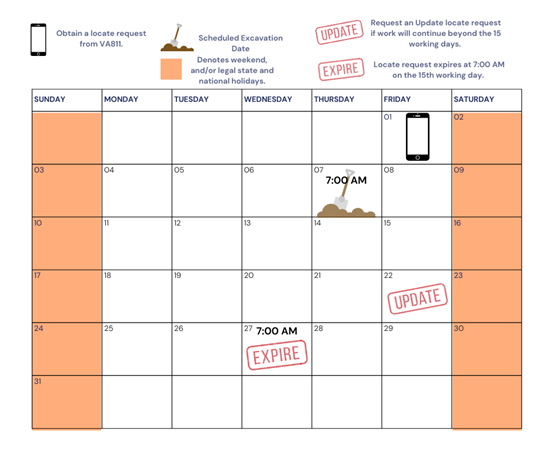
 llow required time for marking.
llow required time for marking.
You must wait the time required by law if VA811 informs you that member operators will be notified of your proposed excavation or demolition.
If you cannot provide VA811 with an electronic email address as a means of automatically receiving responses placed on VA811’s Positive Response System, it is your responsibility to contact VA811 prior to commencing excavation/demolition in order to determine if any responses to your locate request have been recorded (Click on 'Locate Requests and Codes' for more information on the Positive Response System).
Example of a 48-hour waiting period of a non-scheduled locate request:
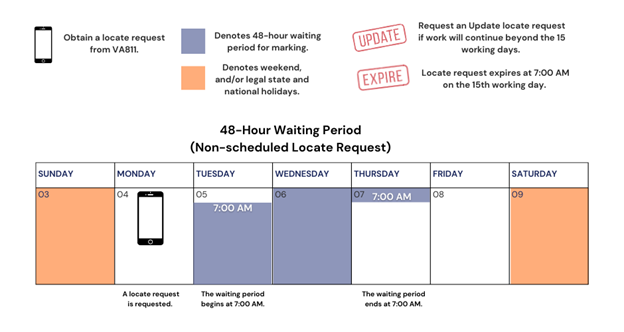
** The waiting period for a scheduled locate request begins at 7AM the next working day and the waiting period ends at 7:00 a.m. the day of the chosen Excavation Date.
 espect the marks.
espect the marks.
 xcavate carefully.
xcavate carefully.
Prior to Excavation
Plan your project to avoid damage, dislocation, or disturbance of underground utility lines.
- Verify you are at the correct location and verify locate markings
- Look for clear evidence of unmarked utility lines.
- Document your findings.
During Excavation
During Backfill Operations
Clear Evidence

Clear evidence includes, but is not limited to:
If clear evidence of an unmarked utility line is identified, notify VA811, and:
Excavating Within Two Feet of Marks
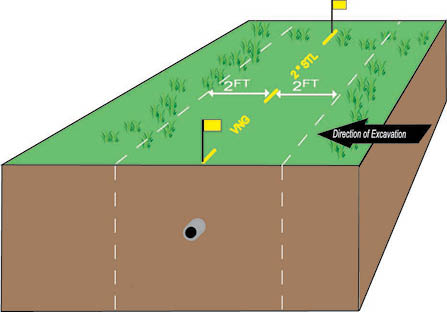
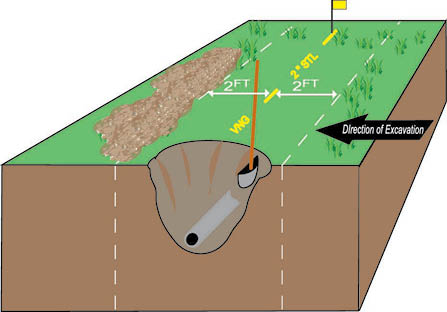
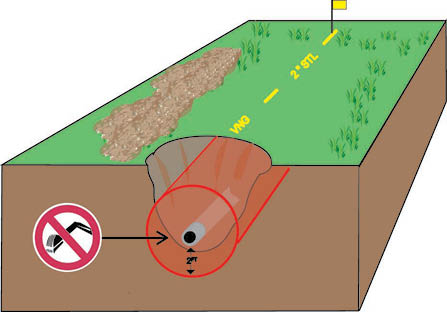
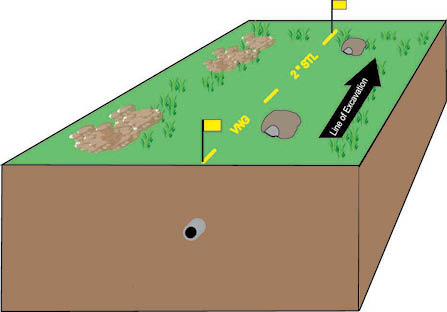
Exposing Underground Utility Lines
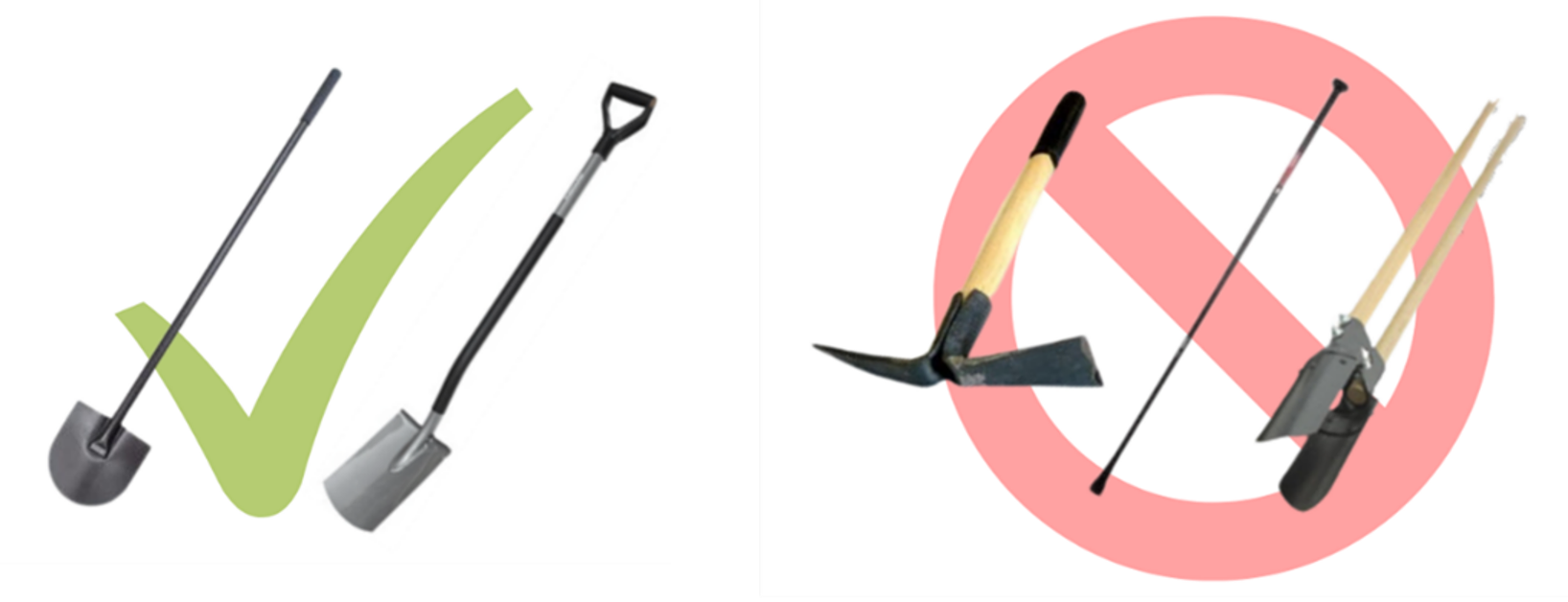
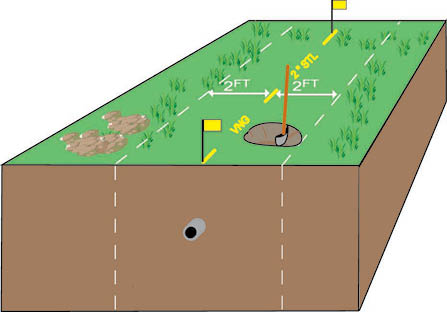
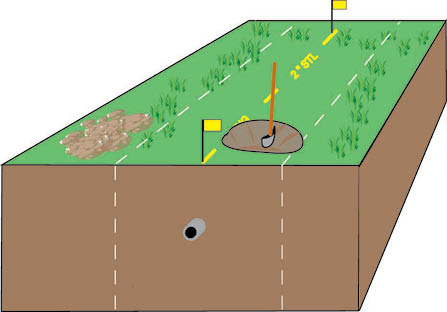
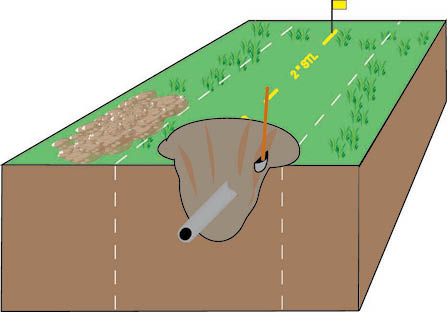
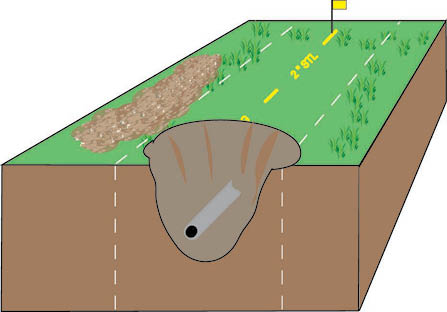
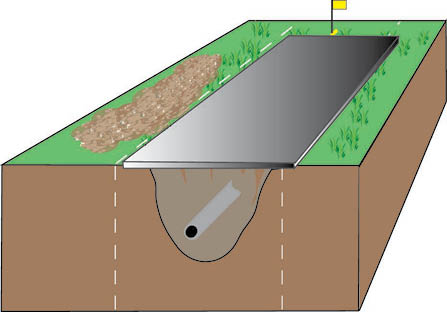
Don’t
Which Utility Lines Will NOT Be Marked?
White Lining Best Practices
Excavators are encouraged to use white lining, when practical, to show the locators the area where excavation will take place. This will reduce the need to precisely describe the area of planned excavation in words, reduce unnecessary work locating underground utility lines that are not involved in the excavation area and reduce unnecessary paint on our streets, roads, sidewalks, etc.
For single point excavation, mark (using white paint) the area by the use of dots or dashes to show the operators/locators the area of excavation. If necessary, use white flags. If utility markings are desired outside a white lined area, provide clear instructions (including distance in feet outside the white lined area) to the notification center. Instances where this would be desirable are installing poles, pedestals, manholes, landscaping, etc. See Figure Below.
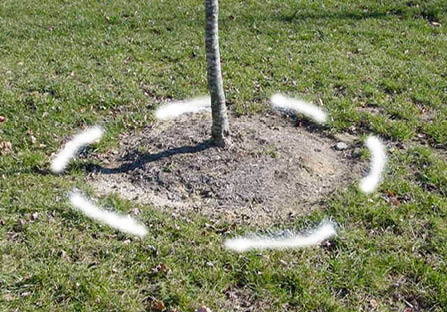
For continuous excavation (trenching, boring, etc.), mark the center line of excavation with dots or dashes. Excavation width (in feet) shall be indicated on either side of the center line in legible figures or noted in the marking instructions given to the notification center. See Figure Below.
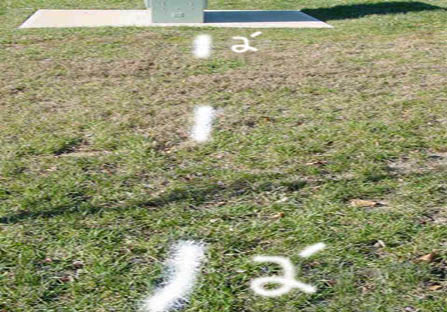
Trenchless Excavation
When conducting trenchless excavation, take all reasonable steps necessary to protect and support underground utility lines. These steps shall include, but are not limited to the following:
Special consideration to help protect water and sewer systems include but are not limited to:
- Use other locating methods such as ground penetrating radar, cameras, fish tapes, sondes, or hand digging to locate the laterals;
- Perform a visual site inspection. Look for clear evidence such as old marks, water meters/crocks, valve boxes, sewer clean-outs, etc.;
- Try to locate water and sewer lateral entrance and exit points at buildings to determine their routes;
- Be aware of patches in pavement that could indicate where water and sewer laterals had been previously uncovered;
- Physically verify the location of the water and sewer laterals and
- Consult the operator of unmarked water and sewer laterals for additional assistance.
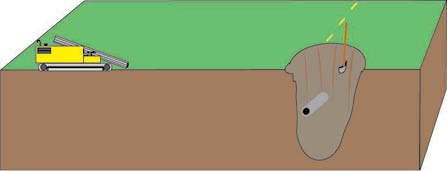
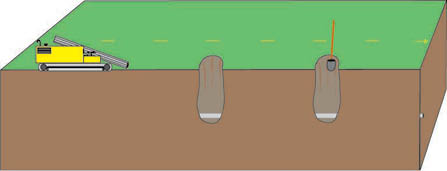
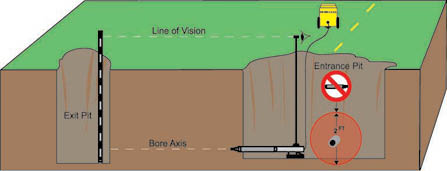
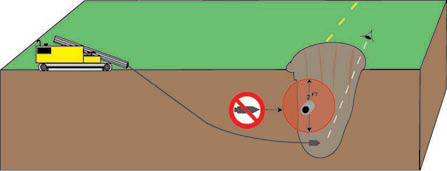
Note: When you can reasonably conclude that a private sewer lateral may be impacted by the use of trenchless technology for the installation or maintenance of gas or electric utility lines based upon visual evidence, knowledge of the proposed excavation site or other available information the following steps must be taken:
Effective July 1, 2018, the following options are available for persons conducting trenchless excavation when crossing gravity fed sewer mains or combination storm/sanitary systems within a county which has adopted the Urban County Executive Form of Government (Contact the applicable county government agency where trenchless excavation will be conducted regarding their form of government.) or any gravity sewer main or combination storm/sanitary sewer system constructed or replaced after January 1, 1995 (Contact the applicable county, city, town, or political subdivision agency where trenchless excavation will be conducted for information regarding the gravity sewer main or combination storm/sanitary sewer system.):
Utility Line Separation
Separation during installation is essential to the safe operation and maintenance of underground utility lines and is required by Virginia law. Installing a utility line without proper separation poses a threat to the health, safety, and welfare of the people of the Commonwealth and the environment. At a minimum, persons installing underground utility lines must comply with the following requirements and standards when applicable.
Visit the following web page to link to laws, rules, documents and standards relative to utility separation in Virginia:
Emergency Excavation
“Emergency” means a sudden or unexpected occurrence involving a clear and imminent danger, demanding immediate action to prevent or mitigate loss of, or damage to, life, health, property, or essential public services
When excavation or demolition is required during an emergency, all reasonable precautions shall be taken to protect underground utility lines that may be located at the site of the excavation. These precautions include, but are not limited to the actions detailed below.
Dispatched personnel or crews responding to the emergency* shall notify VA811 and request an emergency locate of the underground utility lines at the earliest reasonable opportunity.
After arriving at the site, the person responding to the emergency shall determine the need for immediate action;
If immediate action is required, all reasonable precautions shall be taken to protect the underground utility lines. These actions shall include, but are not limited to:
1. Conduct a thorough site assessment to determine the location of underground utility lines;
2. Locate the underground utility lines with acceptable equipment, if possible;
3. Hand dig around the underground utility lines;
4. Directly notify the utility line operators, if necessary; and
5. If prudent, wait for the utility operators to mark their utility lines before proceeding with the excavation.
* For emergency excavations in the vicinity of underground utility lines owned and/or operated by the Virginia Department of Transportation (“VDOT”), contact VDOT’s Statewide Customer Service Center at 800-367-7623 for assistance.
Utility Damage and Resulting Emergencies
Contact Information
The contact information listed below was verified during the latest revision of this publication and is subject to change.
VA811 Member Utility Operators:
Online at http://va811.com/homeowners/three-letter-marking-designation
Virginia Department of Transportation ("VDOT"):
VDOT's Statewide Customer Service Center
(800) 367-7623
Railroad Companies:
Amtrak Emergency Line - (800) 331-0008
Buckingham Branch including Amtrak
(866) 244-4529
Genesee & Wyoming Inc.:
(CA) Chesapeake and Albemarle Railroad (800) 800-3490
(CWRY) Commonwealth Railway (800) 800-3490
(NCVA) North Carolina and Virginia Railroad (800) 800-3490
CSX Transportation including Amtrak
(800) 232-0144
Delmarva Central
844-426-8400
Norfolk Portmouth Belt Line
(757) 271-1708
Norfolk Southern Railway including Amtrak, and the Chesapeake and Western Railroad
(800) 946-4744
Shenandoah Valley Railroad
(877) 686-7245
Winchester and Western Railroad
(800) 533-9416
Know Your Marks - Color Codes
In response to your ticket, operators will mark their underground utility lines in accordance with the Act and the Commission’s General Marking Requirements. In addition, stakeholders in Virginia have agreed on a set of marking best practices contained in the Virginia Underground Utility Marking Standards booklet published by the Commission’s Division of Utility and Railroad Safety. This document is subject to change.
Color Codes
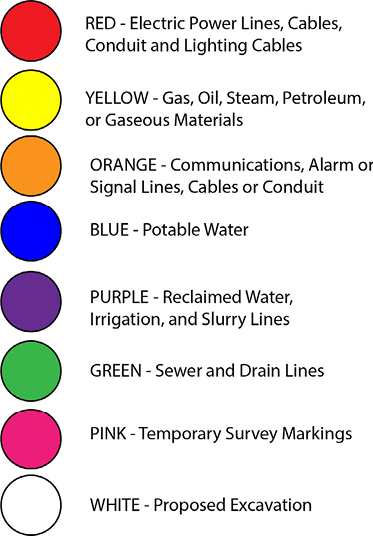

Types of Locate Requests & Positive Response Codes
VA811 has been certified by the Commission to provide notification service for the entire state. Under the direction of a board of director, VA811 operates its primary and back-up notification centers in Roanoke. VA811 must provide notification service in compliance with the Act and Commission’s notification center operational and performance rules. At least 20 percent of the notifications center’s board of directors must be non-operator representatives.
Types of Locate Requests
Normal Locate Request: Before beginning an excavation or demolition, the law requires that you notify VA811. The law allows member operators 48 hours from 7:00 a.m. the next working day after you call VA811 to mark their underground utility lines, or until 7:00 a.m. of the scheduled day of excavation. In addition to contacting VA811 for this ticket type, web ticket entry is also available. A positive response is required for this type of locate request.
Emergency Locate Request: If excavation is necessary due to a sudden or unexpected occurrence involving a clear and imminent danger, demanding immediate action to prevent or mitigate loss of, or damage to, life, health, property, or essential public services, an emergency locate request shall be submitted to VA811. A positive response is not required for this type of locate request.
Remark and Update Locate Request: Notify VA811 any time the line-location markings on the ground become illegible, or three (3) working days before the end of the fifteen day period, if you intend to continue with your excavation. A positive response is required for this type of locate request.
Three-Hour (“3-hour”) Locate Request: A 3-hour locate request shall only be used by the excavator when the excavator has:
The notification center shall accept and process 3-hour locate requests received after the center’s normal business hours. Operators/locators receiving such notices shall respond to the locate request within 3-hours from the excavator’s notice to the notification center. Excavators shall remain on-site for at least 3-hours from their notice to the center (Advisory Committee Policy).
Meeting Locate Request: Excavators who are planning a project of sufficient complexity should request a meeting with the operators who have underground utility lines in the proposed area of excavation. The meeting is to discuss the marking of the operator’s lines, and not to locate and/or mark the lines. Remember, a meeting locate request is not a valid locate request to excavate, and an excavator cannot submit an excavation locate request to VA811 until after the meeting has taken place, or after 7:00 a.m. on the third working day following the meeting locate request. A positive response is required for this type of locate request.
Designer Locate Request: A designer (any licensed professional), designated by a project owner, who prepares drawings and plans for government projects, commercial projects, and residential projects consisting of twenty-five or more units, or industrial projects, that require the approval of governmental or regulatory authorities having jurisdiction over the project area, may notify VA811 and request to receive underground utility line information from the utility operators. A positive response is required for this type of locate request.
Operator’s responsibilities for abandoned utility lines:
Three Hour Deep Locate Request: This locate request is used according with an Advisory Committee Policy when conducting an open trench excavation not parallel to utility markings, the excavation exceeds four (4) feet in depth, and the excavator does not find the utility line, the excavator must first comply with the provisions of § 56-265.24 C and § 56-265.17 C. When providing the additional notice, the excavator will inform the notification center of the details of the crossing. It shall then be considered that the excavator has taken reasonable care to avoid damage to an underground utility line if the excavator hand digs two (2) feet on either side of the marked location of the existing utility line to a depth of two (2) feet below the final depth of the excavation and does not find the utility line.
Upon receipt of the excavator’s additional notice under § 56-265.24 C, the notification center shall transmit the notice to the member utilities or their contract locators. In addition, the notification center will provide a separate notice containing the details of the crossing of any natural gas, hazardous liquid or critical facility as specified by Positive Response Code 70 directly to the affected utility operator(s). Operators and their contract locators will respond in accordance with § 56-265.17 C.
Cancellation or Corrections:
VA811 will accept cancellations and corrections to existing locate requests.
The Positive Response System
- Calling 811;
- Clicking HERE; or
- Receiving an email, fax, LETS, or other mutually acceptable means of automatic transmission that you and VA811 have agreed upon.
Positive Response Codes
The Virginia Damage Prevention Advisory Committee is responsible for approving the Positive Response Codes (“Codes”) and policies that are used in conjunction with the Excavator-Operator Information Exchange System, commonly referred to as the Positive Response System. The Codes are intended to be used as an effective and efficient method of communication between VA811’s member operators or their contract locators and the excavator community regarding the status of a locate request. It is essential that only the appropriate Code be used when updating the status of a locate request. Inappropriate or erroneous use of Codes can cause miscommunication that may result in work delays, utility damages, service interruptions, economic loss, environmental damage, liability claims, civil penalties, injuries or worse!
10 - Marked.
Code 10 shall be used when all utility lines within the area of proposed excavation have been marked.
11 - Marked; abandoned utility lines may be in area.
Code 11 shall be used when all utility lines within the area of proposed excavation have been marked and the operator/locator is aware of the presence of abandoned utility lines.
12 - Marked up to privately owned utility; contact private utility owner for locate.
Code 12 shall be used when all utility lines within the area of proposed excavation have been marked and the operator/locator is aware of the presence of a private utility line.
13 - Marked up to privately owned utility; contact private utility owner for locate. Abandoned utility lines may be in area.
Code 13 shall be used when all utility lines within the area of proposed excavation have been marked and the operator/locator is aware of the presence of both private utility lines and abandoned utility lines.
30 - No conflict; utility is outside of stated work area.
Code 30 shall be used when the operator/locator has determined that no utility lines are in the area of proposed excavation as delineated on the locate request. When the operator/locator has marked facilities that are outside of the area of proposed excavation as delineated on the locate request, in compliance with State Corporation Commission Rule 20VAC5-309-110 I, the operator/locator shall respond to the excavator – operator information exchange system with Code 30.
31 - No conflict; utility is outside of stated work area. Abandoned utility lines may be in area.
Code 31 shall be used when the operator/locator has determined that no utility lines are in the area of proposed excavation as delineated on the locate request and the operator/locator is aware of the presence of abandoned utility lines in the area of proposed excavation as delineated on the locate request. When the operator/locator has marked facilities that are outside of the area of proposed excavation as delineated on the locate request, in compliance with State Corporation Commission Rule 20VAC5-309-110 I, the operator/locator shall respond to the excavator – operator information exchange system with Code 31.
32 - No conflict; privately owned utility on property. Contact private utility owner for locate.
Code 32 shall be used when the operator/locator has determined that no utility lines are in the area of proposed excavation as delineated on the locate request and the operator/locator is aware of the presence of private utility lines in the area of proposed excavation as delineated on the locate request. When the operator/locator has marked facilities that are outside of the area of proposed excavation as delineated on the locate request, in compliance with State Corporation Commission Rule 20VAC5-309-110 I, the operator/locator shall respond to the excavator – operator information exchange system with Code 32.
33 - No conflict; privately owned utility on property. Contact private utility owner for locate. Abandoned utility lines may be in area.
Code 33 shall be used when the operator/locator has determined that no utility lines are in the area of proposed excavation as delineated on the ticket and the operator/locator is aware of the presence of both private utility lines and abandoned utility lines in the area of proposed excavation as delineated on the locate request. When the operator/locator has marked facilities that are outside of the area of proposed excavation as delineated on the locate request, in compliance with State Corporation Commission Rule 20VAC5-309-110 I, the operator/locator shall respond to the excavator – operator information exchange system with Code 33.
40 - Agreed to a meeting as proposed by excavator.
Code 40 shall be used in response to a meeting notice when the operator/locator agrees to a meeting at the specific time and location proposed by the excavator. The meeting must take place by 7:00 a.m. on the third working day following the meeting notice.
41 - Mutually agreed to alternative meeting time and location.
Code 41 shall be used when an operator/locator is unable to attend a meeting as proposed by the excavator. The operator/locator shall set up a mutually agreeable time and location to meet no later than 7:00 a.m. on the third working day following the meeting notice. Both excavator and operator/locator are encouraged to document the arrangements.
50 - Installation records, maps or other documents have been provided.
Code 50 shall be used in response to a designer locate request when the designer does not request field markings to be placed. The information provided by the operator/locator may include, but is not limited to, maps, surveys, installation records, as-built records, or other means.
51 - Records or information regarding private sewer laterals have been provided.
Code 51 shall be used for any of the following conditions:
52 - Records regarding private sewer laterals have been provided on an accessible electronic system.
Code 52 shall be used when the sewer system operator has provided the best reasonably available records regarding the location of private sewer laterals on the Internet or another readily accessible electronic system. If the system’s location is unknown to the excavator, the excavator shall contact the operator to determine the system’s location and how to retrieve the records.
53 - Agreed to an on-site meeting to provide additional information regarding private sewer laterals.
Code 53 shall be used when a sewer system operator has agreed to meet the excavator on-site because the sewer system operator has no records regarding the location of private sewer laterals, but the sewer system operator has additional information to convey to the excavator.
60 - Locator and excavator agreed and documented marking schedule.
Code 60 shall be used when an operator/locator has contacted the excavator and the excavator has agreed to an alternate marking schedule. Operator/locator must document agreement in writing (electronic or paper) to include, at a minimum, full name of excavator representative agreeing to the schedule, the excavator’s phone number, excavator’s signature if possible, reasons for the marking schedule, and date and time of the agreement. The operator/locator must provide the name of the excavator’s representative agreeing to the alternate marking schedule to VA811’s Positive Response System with the use of Code 60.
70 - Critical facility marked. In case of dredging, the approximate horizontal location of the utility line has been identified. Operator must be present during dredging or other forms of excavation or demolition operations.
Code 70 shall only be used when such operations are performed in such proximity to a critical facility that it may be destroyed, damaged, dislocated, or disturbed. If only part of the work area defined on the VA811 Locate Request requires the operator’s presence, it shall be the operator’s responsibility to notify the excavator, clearly delineate when the operator’s presence will be required and document in writing (electronic or paper), the notification to include, at a minimum, full name of excavator representative, the excavator’s phone number, excavator’s signature if possible, and the date and time of the notification. When the operator has indicated its presence is required, it shall be the excavator’s responsibility to notify the operator in advance of excavation in that part of the work area, and document in writing (electronic or paper), the notification to include, at a minimum, full name of operator representative, the operator’s phone number, operator’s signature if possible, and date and time of the notification to the operator. In the case of dredging, an acceptable means of identifying and or marking the approximate horizontal location of the underground utility line must be determined and that information must be provided to the person intending to dredge. For other forms of excavation or demolition, the underground utility line(s) shall be marked. When an operator/locator responds to a locate request with a Code 70, it shall be the operator/locator’s responsibility to provide the excavator/dredger with the appropriate name and preferred contact information, i.e. telephone number, facsimile (“Fax”) number, email address and or mailing address, for the excavator/dredger to use to inform the operator of the date and time when the dredging or other forms of excavation operations will commence.
71 - Critical facility not marked; locator or utility operator must contact excavator and must be present during excavation.
Code 71 shall only be used when the operator’s presence is necessary during the excavation due to the fact that the underground utility line is of such importance to national security that marking it in accordance with the Underground Utility Damage Prevention Act is not appropriate. The operator must be present during excavation or demolition operations when such operations are performed in such proximity to a critical facility that it may be destroyed, damaged, dislocated, or disturbed. If only part of the work area defined on the VA811 Locate Request requires the operator’s presence, it shall be the operator’s responsibility to notify the excavator, clearly delineate when the operator’s presence will be required and document in writing (electronic or paper), the notification to include, at a minimum, full name of excavator representative, the excavator’s phone number, excavator’s signature if possible, and the date and time of the notification. When the operator has indicated its presence is required, it shall be the excavator’s responsibility to notify the operator in advance of excavation in that part of the work area, and document in writing (electronic or paper), the notification to include, at a minimum, full name of operator representative, the operator’s phone number, operator’s signature if possible, and date and time of the notification to the operator. When an operator/locator responds to a locate request with Code 71, it shall be the locator/operator’s responsibility to provide the excavator with the appropriate name and contact information for the excavator to use to inform the operator of the date and time when excavation will commence.
80 - The status of the utility line has been determined to be abandoned.
Code 80 shall be used by an operator when the operator has determined the status of a utility line is abandoned.
81 - Mutually agreed to an alternative time to determine if the utility line is abandoned.
Code 81 shall be used when an excavator and operator have negotiated a mutually agreeable time period in excess of 27 hours for the operator to provide information relative to an abandoned utility line if site conditions prohibit the operator from making such a determination or extraordinary circumstances exist. The operator shall notify the excavator of the date and time when the status of the utility line will be determined. However, the deferral to determine the status of the utility line shall be no longer than 96 hours from 7:00 a.m. on the next working day following the excavator’s additional notice to the notification center.
82 - The utility line in question does not belong to this operator.
Code 82 shall be used when an operator has determined that the alleged abandoned utility line is not owned by that operator.
90 - Locator could not gain access to property; locator will contact excavator.
When an operator/locator responds to a locate request with Code 90, it shall be the operator/locator’s responsibility to contact and inform the excavator of their inability to gain access to the property to mark the area of excavation. The operator/locator must provide the name of the excavator’s representative that they contacted to VA811’s Positive Response System with the use of Code 90. It shall be the excavator’s responsibility to make the property accessible to the operator/locator and call a new locate request for those operators who initially responded to the locate request with a Code 90, if necessary.
91 - Incorrect address information; please call VA811 and provide correct information.
Code 91 shall be used when the excavator has provided incorrect address information to the notification center. The operator/locator shall make a reasonable attempt to contact the excavator to verify the address information before the placement of this code. It shall be the excavator’s responsibility to verify the address information and call the notification center to request a new locate request with the correct information.
93 - Scope of work is too large; please call VA811 to reschedule.
Code 93 shall be used when the area of proposed excavation exceeds the limits of a work area as defined in § 56-265.17 F. It shall be the excavator’s responsibility to call the notification center and request a new locate request or locate requests that complies with § 56-265.17 F.
94 - Failed to provide specific location of proposed excavation, please call VA811 and provide the specific location on a new locate request.
Code 94 shall be used when the excavator has failed to provide the specific location of the proposed excavation. It shall be the excavator's responsibility to call the notification center and request a new locate request with a specific location of proposed excavation, as required by Rule 20VAC5-309-190. Code 94 shall not be used when the specific location given is a single address and no additional excavation area has been specified (adjacent property, road and both sides of the road, 100 feet in all directions of an intersection, etc.).
96 - No response required from this terminal.
Code 96 shall be used if no response is required from a specific terminal ID code. If an operator has multiple terminal codes that overlap, they may choose to use Code 96 to display that a certain terminal is not responding. If a locate request is cancelled, the operator/locator shall use this code to respond. (VA811 will not post responses on a cancelled locate request to the Positive Response System.) If a locate request is transmitted to an operator/locator’s terminal, but field markings are performed by another person under contract with the operator, Code 96 may be used by the operator/locator to convey that they will not respond. The person responsible for marking the utility line is required* to update to the Positive Response System with the current marking status. Operator/locators are encouraged to document the reason that no response was required.
*In the event that the person responsible for marking the utility line is the same as the person requesting the locate request, an additional response is not required.
97 - Extraordinary circumstances exist.
Code 97 is only used in the event that extraordinary circumstances exist. These circumstances may include: floods, snow, ice storms, tornadoes, earthquakes, other natural disasters.
In addition to the Positive Response Codes entered by VA811’s member operators or their contract locators, the Positive Response System generates the following automated responses when applicable:
000 - No Response.
000 This is an automated place holder generated by VA811’s Positive Response System that indicates the member operator has not yet responded and the locate request’s due by date and time has not yet passed. Once a response is posted by the member operator or the due by date and time has passed, the code is removed.
888 - Locate Request Has Been Cancelled.
888 This is an automated response generated by VA811’s Positive Response System when a locate request is cancelled by the person who requested it. Once this response is posted, the system will not accept any further response from any member operator or their contract locator.
999 - Has Not Responded.
999 This is an automated response generated by VA811’s Positive Response System for Normal, Update, Remark, Designer and Meeting locate requests immediately after the due by date and time has passed and a member operator or its contract locator has failed to post a response code to the Positive Response System. A “No Show” locate request is transmitted by VA811 to the member operator as the response 999 is posted to the system.
The Damage Prevention Act
Goals of the Act
The Virginia Underground Utility Damage Prevention Act
Disclaimer of Liability
This reproduction of the Act, and the Commission’s Rules for Enforcement of the Act is provided solely as a convenience for the persons reading this manual, and not as a legal reference. Persons seeking a legal reference should utilize the Code of Virginia and the Virginia Administrative Code.
Be it enacted by the General Assembly of Virginia:
1. That §§ 56-265.15, 56-265.16:1, 56-265.17, 56-265.17:3, 56-265.18, 56-265.19, 56-265.22, 56-265.24, 56-265.31, and 56-265.32 of the Code of Virginia are amended and reenacted and that the Code of Virginia is amended by adding a section numbered 56-265.24:1 as follows:
§ 56-265.14. Short title.
This chapter may be cited as the “Underground Utility Damage Prevention Act.”
§ 56-265.15. Definitions; calculation of time periods.
A. As used in this chapter:
“Abandoned” means no longer in service and physically disconnected from a portion of the underground utility line that is in use for storage or conveyance of service.
“Contract locator” means any person contracted by an operator specifically to determine the approximate horizontal location of the operator’s utility lines that may exist within the area specified by a locate request.
“Damage” means any impact upon or removal of support from an underground facility as a result of excavation or demolition which according to the operating practices of the operator would necessitate the repair of such facility.
“Demolish” or “demolition” means any operation by which a structure or mass of material is wrecked, razed, rendered, moved, or removed by means of any tools, equipment, or discharge of explosives which could damage underground utility lines.
“Designer” means any licensed professional designated by the project owner who designs government projects, commercial projects, residential projects consisting of 25 or more units, or industrial projects, which projects require the approval of governmental or regulatory authorities having jurisdiction over the project area.
“Emergency” means a sudden or unexpected occurrence involving a clear and imminent danger, demanding immediate action to prevent or mitigate loss of, or damage to, life, health, property, or essential public services.
“Excavate” or “excavation” means any operation in which earth, rock, or other material in the ground is moved, removed, or otherwise displaced by means of any tools, equipment, or explosives and includes, without limitation, grading, trenching, digging, ditching, dredging, drilling, augering, tunneling, scraping, cable or pipe plowing and driving, wrecking, razing, rendering, moving, or removing any structure or mass of material. “Excavate” or “excavation” does not include installation of a sign that consists of metal, plastic, or wooden poles placed in the ground by hand or by foot without the use of tools or equipment.
“Exigent circumstances” means circumstances outside of an operator's or contract locator's, as described in subsection D of § 56-265.19, control that necessarily prevent an operator or locator from completing the marking task, including a wrong address provided with the locate request; failure to provide a reasonably specific location of proposed excavation; inaccessibility of the excavation site due to physical barrier or risk of serious bodily injury; a locate request that cannot be carried out by a traditional locating method and requires assistance from the operator; catastrophic technological failure outside of the locator's, operator's, or notification center's control; or the area of excavation does not conform with the requirements of subsection F of § 56-265.17.
“Extraordinary circumstances” means floods, snow, ice storms, tornadoes, earthquakes, or other natural disasters.
“Hand digging” means any excavation involving non mechanized tools or equipment. Hand digging includes, but is not limited to, digging with shovels,picks, and manual post hole diggers, vacuum excavation or soft digging.
“Locate request” means the completed delivery of information to the notification center requesting markings for a specified area of excavation or demolition and receipt of the same by the notification center in accordance with this chapter.
“Notification center” means an organization whose membership is open to all operators of underground facilities located within the notification center’s designated service area, which maintains a data base, provided by its member operators, that includes the geographic areas in which its member operators desire transmissions of notices of proposed excavation, and which has the capability to transmit, within one hour of receipt, notices of proposed excavation to member operators by electronic means.
“Notify,” “notice” or “notification” means the completed delivery of information to the person to be notified, and the receipt of same by such person in accordance with this chapter. The delivery of information includes the use of any electronic or technological means of data transfer.
“Operator” means any person who owns, furnishes or transports materials or services by means of a utility line.
“Person” means any individual, operator, firm, joint venture, partnership, corporation, association, municipality, or other political subdivision, governmental unit, department or agency, and includes any trustee, receiver, assignee, or personal representative thereof.
“Positive Response” means a code or phrase posted by an operator or locator to the notification center detailing the marking status of a locate request.
“Positive Response System” means the excavator-operator information exchange system that is required by subsection E of § 56-265.16:1 and provides the means for operators or their contract locators to respond to and report the marking status of a locate request.
“Private sewer lateral” means a privately owned, legally authorized utility line that transports wastewater from one or more buildings to a sewer system utility line owned by a sewer system operator.
“Private water lateral” means a privately owned, legally authorized utility line that supplies water from a water system utility line owned by a water system operator to one or more buildings or properties.
“Sewer system” means a system of utility lines used for conveying wastewater, and includes sewer system laterals but does not include private sewer laterals.
“Sewer system lateral” means a lateral utility line located in the public right-of- way or public sewer easement, owned by a sewer system operator, and used to transport wastewater to the operator’s main sewer line.
“Sewer system operator” means an operator of a sewer system.
“Soft digging” means any excavation using tools or equipment that utilize air or water pressure as the direct means to break up soil or earth for removal by vacuum excavation.
“Utility line” means any item of public or private property which is buried or placed below ground or submerged for use in connection with the storage or conveyance of water, sewage, telecommunications, electric energy, cable television, oil, petroleum products, gas, or other substance, and includes pipes, sewers, combination storm/sanitary sewer systems, conduits, cables, valves, lines, wires, manholes, attachments, and those portions of poles below ground. The term “sewage” does not include any gravity storm drainage systems. Except for any publicly owned gravity sewer system within a county which has adopted the urban county executive form of government, the term “utility line” does not include any gravity sewer system or any combination gravity storm/sanitary sewer system within any counties, cities, towns or political subdivisions constructed or replaced prior to January 1, 1995. No excavator shall be held liable for the cost to repair damage to any such systems constructed or replaced prior to January 1, 1995, unless such systems are located in accordance with § 56-265.19.
“Water system” means a system of utility lines used for supplying water, and does not include private water laterals.
“Water system operator” means an operator of a water system.
“Willful” means an act done intentionally, knowingly, and purposely, without justifiable excuse, as distinguished from an act done carelessly, thoughtlessly, heedlessly or inadvertently.
“Working day” means every day, except Saturdays, Sundays, and legal state and national holidays.
B. Unless otherwise specified, all time periods used in this chapter shall be calculated from the time of the original locate request as provided in § 56-265.17. In addition, all time periods exclude Saturdays, Sundays, and legal state and national holidays.
§ 56-265.15:1. Exemptions; routine maintenance.
Nothing in this chapter shall apply to:
1. Any hand digging performed by an owner or occupant of a property.
2. The tilling of soil for agricultural purposes.
3. Any excavation done by a railroad when the excavation is made entirely on the land which the railroad owns and on which the railroad operates, provided there is no encroachment on any operator’s rights-of-way or easements.
4. An excavation or demolition during an emergency, as defined in § 56-265.15 provided all reasonable precaution has been taken to protect the underground utility lines.
In the case of the state highway systems or streets and roads maintained by political subdivisions, officials of the Department of Transportation or the political subdivision where the use of such highways, roads, streets or other public way is impaired by an unforeseen occurrence shall determine the necessity of repair beginning immediately after the occurrence.
5. Any excavation for routine pavement maintenance, including patch type paving or the milling of pavement surfaces, upon the paved portion of any street, road, or highway of the Commonwealth provided that any such excavation does not exceed a depth of twelve inches (0.3 meter).
6. Any excavation for the purpose of mining pursuant to and in accordance with the requirements of a permit issued by the Department of Mines, Minerals and Energy.
7. Any hand digging performed by an operator to locate the operator’s utility lines in response to a notice of excavation from the notification center, provided all reasonable precaution has been taken to protect the underground utility lines.
8. Any installation of a sign that does not involve excavation as defined in § 56-265.15.
§ 56-265.16. Repealed by Acts 1989, c. 448, effective July 1, 1990.
§ 56-265.16:1. Operators to join notification centers; certification.
A.Every operator, including counties, cities and towns, but excluding the Department of Transportation, having the right to bury underground utility lines shall join the notification center for the area.
B.Every notification center shall be certified by the Commission. The Commission shall determine the optimum number of notification centers in the Commonwealth. If the Commission determines that there shall be more than one notification center in the Commonwealth, it shall define the geographic area to be served by each notification center.
C.Any corporation desiring to serve as the notification center for an area of the Commonwealth may apply to the Commission to be certified as the notification center for that area. The Commission shall have authority to grant, amend, or revoke certificates under regulations promulgated relating to certification. An application for certification shall include such information as the Commission may reasonably require addressing the applicant’s operational plan for the notification center.
D.Every Commission action regarding the optimum number of notification centers, the geographic area to be served by each notification center, the promulgation of notification center certification regulations, and the grant, amendment, or revocation of notification center certifications shall be made in furtherance of the purpose of preventing or mitigating loss of, or damage to, life, health, property or essential public services resulting from damage to underground utility lines. Any action by the Commission to approve or revoke any notification center certification shall:
1. Ensure protection for the public from the hazards that this chapter is intended to prevent or mitigate;
2. Ensure that all persons served by the notification center receive an acceptable level of performance, which level shall be maintained throughout the period of the notification center’s certification; and
3. Require the notification center and its agents to demonstrate financial responsibility for any damages that may result from their violation of any provision of this chapter. Such requirement may be met by purchasing and maintaining liability insurance on such terms and in such amount as the Commission deems appropriate.
E.A notification center shall maintain a positive response system in accordance with notification center certification regulations promulgated by the Commission. The members of a notification center shall be responsible for developing and implementing a public awareness program to ensure that all parties affected by this chapter shall be aware of their responsibilities. There shall be only one notification center certified for each geographic area defined by the Commission.
§ 56-265.17. Notification required prior to excavation or demolition; waiting periods; marking of proposed site.
A.No person shall make or begin any excavation or demolition without first submitting a locate request to the notification center. Submission of a locate request shall be deemed to be notice to each operator who is a member of the notification center. The notification center shall provide the excavator with the identity of utilities that will be notified of the proposed excavation or demolition. Except for counties, cities, and towns, an excavator who willfully fails to submit a locate request for a proposed excavation or demolition shall be liable to the operator whose facilities are damaged by that excavator, for three times the cost to repair the damaged property, provided that the operator is a member of the notification center. The total amount of punitive damages awarded under this section, as distinguished from actual damages, shall not exceed $10,000 in any single cause of action.
B.Except in the case of an emergency as defined in § 56-265.15 or in cases subject to subsection C, the excavator shall only commence work:
1. After the excavator has confirmed, by reviewing the positive response information posted on the notification center's positive response system, that each operator has marked its utility lines, notified the notification center that its utility lines are not present in the area of proposed excavation, or otherwise posted a positive response indicating excaation may begin; or
2. If informed by the notification center that no operators are to be notified.
If any operator fails to respond to the positive response system as required by this chapter, the notification center shall re-notify any operator of its failure. This re-notification shall not constitute an exemption from the duties of the operator set forth in § 56-265.19.
C.If, after at least 48 hours beginning with 7:00 a.m. the next working day following a locate request or on the date of excavation, the excavator, upon arrival at the site of a proposed excavation, observes clear evidence of the presence of an unmarked utility line in the area of the proposed excavation, the excavator shall not begin excavating until three hours after an additional contact is made to the notification center for the area, provided that no information has been posted to the positive response system or information posted to the positive response system is inconsistent with the clear evidence observed by the excavator.
The operator of any unmarked utility line shall respond within three hours of the excavator’s contact to the notification center. After the clear evidence of an unmarked utility line is addressed pursuant to the additional contact to the notification center, excavation may proceed. During any excavation subject to this subsection, the excavator shall exercise reasonable care at all times to protect underground utility lines and shall be liable for any damages.
D.The excavator’s notification shall be valid for fifteen working days from 7:00 a.m. on the next working day following notice to the notification center. Three working days before the end of the fifteen-working-day period, or at any time when line-location markings on the ground become illegible, the excavator intending to excavate shall contact the notification center and request the re- marking of lines. The operator shall re-mark the lines as soon as possible; however, the re-marking of the lines shall be completed within forty-eight hours from 7:00 a.m. on the next working day following the request for the re-mark. Such re-marking shall be valid for an additional fifteen working days from 7:00 a.m. on the next working day following notice to the notification center.
E.If a specific location of the excavation cannot be given as required by subdivision 2 of § 56-265.18, prior to notifying the notification center pursuant to subsection A, the person proposing to excavate or demolish shall mark the route or boundary of the site of the proposed excavation or demolition by means of white paint, if practical.
F.The extent of the excavator’s proposed excavation or demolition shall be a work area that can be excavated within 15 working days from 7:00 a.m. on the next working day following a locate request. The area covered under each locate request shall not exceed one-third of a mile.
§ 56-265.17:1. Notification and procedures for designers.
A.Each designer, who prepares drawings and plans for projects requiring excavation or demolition work, may notify the notification center and provide the center with the information required by § 56-265.18 and the designer’s professional license number.
B.If a designer notifies the notification center to receive underground utility line information in accordance with § 56-265.17:3, the designer shall:
1. Indicate on the construction drawings, the type of underground utility lines, the horizontal location of these lines as provided by the operators, and the names of the operators of these lines;
2. Consider, when designing a project and preparing drawings therefor, the location of existing underground lines so as to minimize damage or interference with the existing facilities;
3. Indicate, on the construction plans or drawings, the designer ticket number and the notification center’s toll-free number; and
4. Request only one designer ticket per project through the notification center at no cost.
§ 56-265.17:2. Procedures for project owners.
The project owner shall provide copies of those portions of the drawings that affect the respective operator with underground utility lines in the project area who have responded in accordance with § 56-265.17:3.
§ 56-265.17:3. Procedures for operators in response to a designer notice.
An operator, upon notification by a designer in accordance with § 56-265.17:1, shall:
1. Respond to the designer’s request for underground utility line information within 15 working days in accordance with subdivisions 2, 3, and 4;
2. Provide designers with the operator’s name, the type of underground utility line, and the approximate horizontal location of the utility line. The foregoing information may be provided to the designer through the means that include field locates, maps, surveys, installation records or other means. Marking shall be done by both paint and flags whenever possible;
3. Provide such information about the location of the utility lines to designers for informational purposes only. Operators will not be liable for any incorrect information provided or for the subsequent use of this information, nor will they be subject to civil penalties for the accuracy of the information or marks provided. Any concerns about the accuracy of information or marks should be directed to the appropriate operator; and
4. Respond to the positive response system by no later than 7:00 a.m. on the sixteenth working day following the designer’s locate request.
§ 56-265.18. Notification requirements.
Every locate request and designer notice served by any person on the notification center shall contain the following information:
1. The name of the individual serving such notice.
2. The specific location of the proposed excavation or demolition. If a specific description of the location of the excavation cannot be given, the person proposing to excavate or demolish shall comply with subsection E of § 56-265.17.
3. The name, physical address, telephone number, and electronic mailing address, if available, of the excavator or demolisher, to whom notification can be given.
4. The excavator’s or demolisher’s field telephone number and, if available, electronic emailing address.
5. The type and extent of the proposed excavation or demolition.
6. The name of the person for whom the proposed excavation or demolition is being performed.
§ 56-265.19. Duties of operator; regulations.
If a proposed excavation or demolition is planned in such proximity to the underground utility line that the utility line may be destroyed, damaged, dislocated, or disturbed, the operator shall mark the approximate horizontal location of the underground utility line on the ground to within two feet of either side of the underground utility line by means of stakes, paint, flags, or a combination thereof.
The operator or contract locator shall mark the underground utility line and report the marking status to the positive response system by no later than 7:00 a.m. on the third working day following the excavator’s locate request, unless a scheduled excavation date is provided by the excavator to the notification center or the operator or contract locator is unable to do so due to extraordinary or exigent circumstances.
Any scheduled excavation date shall not be less than 48 hours nor more than 12 working days from the date of the locate request. If a scheduled excavation date is provided by the excavator to the notification center, the operator or contract locator shall mark the underground utility line and report the marking status to the positive response system by no later than 7:00 a.m. on the scheduled day of excavation.
Any locate request made on a day that is not a working day shall be considered as having been submitted to the notification center on the next working day at 7:00 a.m.
If the operator is unable to mark the location within the time allowed under this section due to extraordinary or exigent circumstances, the operator shall notify directly the person who proposes to excavate or demolish and shall, in addition, notify the person of the date and time when the location will be marked.
The deferral to mark for extraordinary or exigent circumstances shall be no longer than 96 hours from 7:00 a.m. on the next working day following the locate request, unless a longer time is otherwise agreed upon by the operator and excavator.
The operator shall also inform the notification center of any deferral.
Note to reader: The VA811 Call Center will soon deploy a feature with the One Call system facilitating the scheduling of locate requests pursuant to this Section.
B.If a proposed excavation or demolition is not planned in such proximity to the operator’s underground utility lines that the utility line may be damaged, the operator shall so report to the notification center’s positive response system no later than 7:00 a.m. on the third working day following the excavator’s locate request.
C.An operator shall participate in all pre-planning and pre-construction meetings originated by state, county or municipal authorities relating to proposed construction projects which may affect the operator’s existing or future utility lines and shall cooperate in implementing decisions reached in such pre-planning and pre-construction meetings.
D.Any contract locator acting on behalf of an operator and failing to perform the duties imposed by this chapter shall be subject to the liabilities in § 56-265.25 and the civil penalties in § 56-265.32.
E.Locators shall be trained in applicable locating industry standards and practices no less stringent than the National Utility Locating Contractors Association’s locator training standards and practices. Each locator’s training shall be documented. Such documents shall be maintained by the operator or contract locator.
F.The Commission shall be authorized to adopt regulations designating: (i) letters for each operator to be used in conjunction with marking of underground utility lines, and (ii) symbols for marking of underground utility lines, in compliance with subdivision 2 of § 56-265.17:3. Such letter designation and marking symbols shall be in accordance with industry standards.
G.For underground utility lines abandoned after July 1, 2002, operators shall make a reasonable attempt to keep records of these abandoned utility lines, excluding service lines connected to a single-family dwelling unit. When an operator has knowledge that the operator’s abandoned utility lines may be present within the area of the proposed excavation, the operator shall provide a response to the positive response system. Such information regarding abandoned lines shall be for informational purposes only. An operator shall not be liable to any person, or subject to civil penalties, as a result of the operator’s providing incorrect information regarding abandoned lines or the subsequent use of such information. The positive response system may refer any person with concerns about the accuracy of information regarding abandoned lines to the appropriate operator.
H.An operator shall respond to an emergency notice as soon as possible but no later than three hours from the excavator’s contact to the notification center.
§ 56-265.19:1. Private sewer laterals and sewer system laterals.
A.Notwithstanding any provision of this chapter to the contrary, the protection of sewer system laterals and private sewer laterals shall be implemented as provided in this section. When an excavation is to take place within a public right-of-way or public sewer easement, the sewer system operator shall exercise reasonable care to mark the approximate horizontal location of sewer system laterals within the public right-of-way or public sewer easement as provided in § 56-265.19.
B.When (i) an excavation is to take place outside the public right-of-way or public sewer easement, (ii) the excavation involves the installation or maintenance of gas or electric utility lines by trenchless technology, (iii) the potential for a conflict with a sewer lateral exists, and (iv) sewer system laterals are located in the public right-of-way:
1. The sewer system operator shall exercise reasonable care to mark the approximate horizontal location of sewer system laterals by:
a. Marking the location of the sewer system lateral where it meets the edge of the right-of-way or public sewer easement, if known; or
b. If the location described in subdivision B 1 a is unknown, marking the location where the sewer system lateral connects to the sewer system main.
2. When the sewer system laterals have been marked in accordance with subdivision B 1 and the excavator reasonably concludes that a private sewer lateral may be impacted by the planned excavation based upon visual evidence, knowledge of the proposed excavation site, or other information available to the excavator, the excavator shall exercise reasonable care to protect the private sewer lateral. For purposes of this subdivision, reasonable care includes the following actions:
a. Reviewing information provided by the private sewer lateral owner;
b. Meeting with the sewer system operator on-site, if the sewer system operator has additional information to provide about the location of private sewer laterals; or
c. Conducting a visual inspection of the proposed excavation site in an effort to determine the probable path of the sewer lateral.
C.When (i) an excavation is to take place within or outside the public right-of-way or public sewer easement, (ii) the excavation involves the installation or maintenance of gas or electric utility lines by trenchless technology, (iii) the potential for a conflict with a sewer lateral exists, and (iv) private sewer laterals are located in the public right-of-way or easement:
1. The sewer system operator shall assist the excavator by one of the following methods, unless the operator marks private sewer laterals in the manner required for its sewer system laterals under subsection B:
a. Provide copies of the best reasonably available records regarding the location of the private sewer laterals by electronic message, mail, facsimile, or other delivery method. If an excavation affects 25 or more private sewer laterals, the sewer system operator’s response shall be in accordance with the timelines set forth in § 56-265.17:3. If the provision of records required by this subsection imposes an unreasonable burden or substantial cost upon a sewer system operator, the excavator and the sewer system operator shall endeavor in good faith to reach an agreement to provide the sewer system operator with additional time to provide the records or any other mutually agreeable accommodation.
b. Provide the best reasonably available records on the Internet or another readily accessible electronic system in order that the records may be retrieved by the excavator from a remote location. If the sewer system operator has implemented such a system, then the sewer system operator shall have no further obligations to provide records under subdivision C 1 a.
c. If the sewer system operator has no such records, but has additional information to provide about the location of private sewer laterals, then the sewer system operator shall notify the excavator of such information and, upon request, either meet with the excavator on-site or convey such information to the excavator.
2. When the records have been made available in accordance with subdivision C 1 and the excavator reasonably concludes that a private sewer lateral may be impacted by the planned excavation based upon visual evidence, knowledge of the proposed excavation site, or other information available to the excavator, the excavator shall exercise reasonable care to protect the private sewer lateral. For purposes of this subdivision, reasonable care includes the following actions:
a. Reviewing information provided by the sewer system operator;
b. Reviewing information provided by the private sewer lateral owner;
c. Meeting with the sewer system operator on-site if the sewer system operator has additional information to provide about the location of private sewer laterals; or
d. Conducting a visual inspection of the proposed excavation site in an effort to determine the probable path of the sewer lateral.
D.Sewer system operators shall mark utility lines, other than sewer system laterals and private sewer laterals, as provided by other sections of this chapter.
E.Water system operators shall mark water system utility lines as provided by other sections of this chapter, except that a water system operator shall not be responsible for marking private water laterals.
F.Records regarding the location of private sewer laterals provided on the Internet or otherwise made accessible by an electronic system pursuant to subdivision C 1 b shall also be accessible to other public utilities and cable operators or excavators working on their behalf for purposes of compliance with this chapter.
G.In all excavations, the excavator shall exercise reasonable care to protect underground utility lines.
§ 56-265.20. Repealed by Acts 1994, c. 890, effective January 1, 1995.
§ 56-265.20:1. Locating nonmetallic underground utility lines.
Notwithstanding the provisions of § 56-257.1, any plastic or other nonmetallic utility lines installed underground on and after July 1, 2002, shall be installed in such a manner as to be locatable by the operator for the purposes of this chapter.
§ 56-265.21. Marking by color.
In marking the approximate location of underground utility lines or proposed excavation if required pursuant to subsection E of § 56-265.17 the American Public Works Association color codes shall be used.
§ 56-265.22. Duties of notification center upon notification by person intending to excavate; record of notification made by telephone required.
A.The notification center shall, upon receiving notice by a person, notify all member operators whose utility lines are present in the area of the proposed project, excavation or demolition. The notification center shall also indicate the names of those operators being notified to the person providing notice.
B.If the notification required by this chapter is made by telephone, a record of such notification shall be maintained by the operators or notification center notified to document compliance with the requirements of this chapter, and such records shall be maintained in compliance with the applicable statute of limitations.
C.The notification center shall notify excavators, within the time frame allowed by the law to mark underground utility lines, of any responses placed on the positive response system by a locator. Such notification shall occur by mutually acceptable means of automatically transmitting and receiving this information.
If the excavator cannot provide the notification center with a mutually acceptable means of automatically transmitting and receiving this information, it shall be the excavator’s responsibility to contact the positive response system after the period allowed by law to mark underground facilities and prior to commencing excavation in order to determine if any responses to the notice have been recorded.
§ 56-265.22:1. Meetings between excavators and operators.
A.Any person planning excavation or demolition in such proximity to the underground utility lines that the utility lines may be destroyed, damaged, dislocated, or disturbed may request a meeting with the operator whose underground utility lines are located in the area of the proposed excavation or demolition to discuss the marking of such lines. The project requiring excavation shall be of sufficient complexity to require a pre-marking meeting. The meeting notice shall include all information required by § 56-265.18 and a specific time and location for the meeting.
B.The notification center shall, upon receiving a meeting notice, notify all member operators whose underground utility lines are located in the area of the proposed excavation or demolition. The notification center shall provide to the excavator the names of those operators being notified of the meeting.
C.The operators notified by the notification center shall meet with the excavator by 7:00 a.m. on the third working day following the excavator’s meeting notice. If an operator does not agree to the excavator’s suggested time and location, the operator shall set up a mutually agreeable time and location to meet no later than 7:00 a.m. on the third working day following the meeting notice.
D.The excavator’s meeting notice shall not be the notice to excavate required under § 56-265.17. The notice to excavate required under § 56-265.17 for the project shall not be submitted to the notification center until after the meeting referenced in subsection A of this section has occurred, or after 7:00 a.m. on the third working day following the meeting notice.
§ 56-265.23. Exemption for roadway maintenance operations by the Virginia Department of Transportation and certain counties, cities, and towns.
Employees of the Virginia Department of Transportation acting within the scope of their employment, and certain employees of those counties, cities, and towns which maintain their streets or roads in accordance with § 33.1-23.5:1 or § 33.1-41.1 performing street or roadway maintenance operations and acting within the scope of their employment, excavating entirely within the right-of-way of a public road, street or highway of the Commonwealth shall not be required to comply with the provisions of this chapter if reasonable care is taken to protect the utility lines placed in the right-of-way by permit and if they:
1. Excavate within the limits of the original excavation; on the traveled way, shoulders or drainage features of a public road, street, or highway and any excavation does not exceed eighteen inches (0.45 meter) in depth below the grade existing prior to such excavation; or
2. Are replacing previously existing structures in their previous locations.
§ 56-265.24. Duties of excavator.
A.No excavator shall begin any excavation or demolition before reviewing and heeding the positive response marking status of the excavation area. Any person excavating within two feet on either side of the staked or marked location of an operator’s underground utility line or demolishing in such proximity to an underground utility line that the utility line may be destroyed, damaged, dislocated or disturbed shall take all reasonable steps necessary to properly protect, support and backfill underground utility lines. For excavations not parallel to an existing underground utility line, such steps shall include, but may not be limited to:
1. Exposing the underground utility line to its extremities by hand digging;
2. Not utilizing mechanized equipment within two feet of the extremities of all exposed utility lines; and
3. Protecting the exposed utility lines from damage.
In addition, for excavations parallel to an existing utility line, such steps shall include, but may not be limited to, hand digging at reasonable distances along the line of excavation. The excavator shall exercise due care at all times to protect underground utility lines when exposing these lines by hand digging.
B.If the markings locating the underground lines become illegible due to time, weather, construction, or any other cause, the person performing the excavation or demolition shall so notify the notification center for the area. Such notification shall constitute an extension under subsection D of § 56-265.17.
C.If, after at least 48 hours beginning with 7:00 a.m. the next working day following a locate request or on the date of excavation, upon arrival at the site of a proposed excavation, the excavator observes clear evidence of the presence of an unmarked utility line in the area of the proposed excavation, the excavator shall not begin excavating until three hours after an additional contact is made to the notification center for the area pursuant to subsection C of § 56-265.17 and the excavator has verified that no information has been posted to the positive response system or information posted to the positive response system is inconsistent with the clear evidence observed by the excavator.
D.In the event of any damage to, or dislocation, or disturbance of any underground utility line including its appurtenances, covering, and coating, in connection with any excavation or demolition, the person responsible for the excavation or demolition operations shall immediately notify the operator of the underground utility line and shall not backfill around the underground utility line until the operator has repaired the damage or has given clearance to backfill. The operator shall either commence repair of the damage or give clearance to backfill within twenty-four hours, and upon his failure to commence or prosecute with diligence such repair or give clearance, the giving of clearance shall be presumed.
E.If the damage, dislocation, or disturbance of the underground utility line creates an emergency, the person responsible for the excavation or demolition shall, in addition to complying with subsection D, take immediate steps reasonably calculated to safeguard life, health and property.
F.With the exception of designers requesting marking of a site, in accordance with § 56-265.17, no person, including operators, shall request marking of a site through a notification center unless excavation shall commence within thirty working days from the date of the original notification to the notification center. Except for counties, cities, and towns, any person who willfully fails to comply with this subsection shall be liable to the operator for three times the cost of marking its utility line, not to exceed $1,000.
G. Any person performing excavation or demolition shall provide to the operator of the underground utility line in the area of excavation or to the appropriate regulatory authority having jurisdiction, the number issued by the notification center for that excavation site in response to the excavator’s notice, within one hour of a request for the number issued by the notification center.
H.If an excavator discovers an unmarked line, the excavator shall protect this line pursuant to subsection C. An excavator shall not remove an abandoned line without first receiving authorization to do so by the operator.
§ 56-265.24:1. Request to cease operation; immediate threat; penalty.
Notwithstanding the provisions of § 56-265.15:1, any person, as defined in § 56-265.15, who knowingly and intentionally excavates after being notified by a representative of the Commission of a determination that such excavation constitutes an immediate threat to safety or property and such representative requests that excavation cease is guilty of a Class 6 felony. The representative of the Commission shall immediately notify the agency with primary law-enforcement authority over the area of excavation, as well as the fire marshal, (i) that such excavation site is a threat to safety or property and (ii) of the request to cease excavation.
§ 56-265.25. Liability of operator and excavator; penalties.
A.
1. If any underground utility line is damaged as a proximate result of a person’s failure to comply with any provision of this chapter, that person shall be liable to the operator of the underground utility line for the total cost to repair the damaged facilities as that cost is normally computed by the operator, provided the operator is a member of the notification center covering the area in which the damage to the utility line takes place. The liability of such a person for such damage shall not be limited by reason of this chapter.
2. Any person who willfully fails to notify the notification center of proposed excavation or demolition shall be liable to the operator as provided in subsection A of § 56-265.17.
3. If, after receiving proper notice, an operator fails to discharge a duty imposed by any provision of this chapter and an underground utility line of such operator is damaged, as a proximate result of the operator’s failure to discharge such duty, by any person who has complied with all of the provisions of this chapter, such person shall not be so liable.
B.If an underground utility line of an operator is damaged, as the proximate result of the operator’s failure to comply with any provision of this chapter, by any person who has complied with the provisions of this chapter, the operator shall be liable to such person for the total cost to repair any damage to the equipment or facilities of such person resulting from such damage to the operator’s underground utility line.
C.Except as specifically set forth herein, the provisions of this chapter shall not be construed to either abrogate any rights, duties, or remedies existing under law or create any rights, duties, defenses, or remedies in addition to any rights, duties, or remedies existing under law.
§ 56-265.26. Repealed by Acts 1994, c. 890, effective January 1, 1995.
§ 56-265.26:1. Utility line depth requirement.
Every operator having the right to install underground utility lines shall install such underground utility lines at depths required by accepted industry standards. Such standards shall include, as applicable, standards established by the National Electrical Safety Code, Bellcore Blue Book-Manual of Contractor’s Procedures, the Commission’s pipeline safety regulations, the Department of Health’s waterworks regulations, and the depth standards of the Virginia Cable Telecommunications Association, which shall be established in consultation with the State Corporation Commission no later than July 1, 2002.
§ 56-265.27. Repealed by Acts 2015, c. 709, cl. 2.
§ 56-265.28. Sovereign immunity.
Nothing in this chapter shall be construed to abrogate the immunity from suit accruing to the Commonwealth, her political subdivisions, agencies, officers or employees, or the officers or employees of her political subdivisions and agencies, as exists prior to July 1, 1980.
§ 56-265.29. Other similar laws.
Compliance with the provisions of this chapter shall not exempt any operator or person from the operation of any other applicable laws, ordinances, regulations, or rules of governmental and regulatory authorities having jurisdiction, unless exempted by such other laws, ordinances, regulations, or rules as a result of such compliance.
§ 56-265.30. Authority of the State Corporation Commission.
A.The Commission shall enforce the provisions of the Underground Utility Damage Prevention Act as set out in this chapter. The Commission may promulgate any rules or regulations necessary to implement the Commission’s authority to enforce this chapter.
B.Nothing in this chapter shall be construed to authorize the Commission to promulgate any rules or regulations pursuant to its authority to enforce this chapter that require any person, other than jurisdictional gas or hazardous liquid operators, to report to the Commission any probable violation of this chapter or any incident involving damage, dislocation or disturbance of any utility line.
§ 56-265.31. Commission to establish advisory committee.
A.The Commission shall establish an advisory committee consisting of representatives of the following entities: Commission staff, utility operator, notification center, excavator, municipality, Virginia Department of Transportation, Board for Contractors, and underground line locator. Persons appointed to the advisory committee by the Commission shall have expertise with the operation of the Underground Utility Damage Prevention Act. The advisory committee shall perform duties which may be assigned by the Commission, including reviewing reports of violations of the chapter, establishing positive response codes for use by the notification center's positive response system, and making recommendations to the Commission.
B.The members of the advisory committee shall be immune, individually and jointly, from civil liability for any act or omission done or made in performance of their duties while serving as members of such advisory committee, but only in the absence of willful misconduct.
§ 56-265.32. Commission to impose civil penalties for certain violations; establishment of Underground Utility Damage Prevention Special Fund.
A.The Commission may, by judgment entered after a hearing on notice duly served on any person not less than 30 days before the date of the hearing, impose a civil penalty not exceeding $10,000 for each violation of subsection A of § 56-265.17 and $5,000 for all other violations of this chapter, if it is proved that the person violated any of the provisions of this chapter as a result of a failure to exercise reasonable care. Any proceeding or civil penalty undertaken pursuant to this section shall not prevent nor preempt the right of any party to obtain civil damages for personal injury or property damage in private causes of action. This subsection shall not authorize the Commission to impose civil penalties on any county, city or town. However, the Commission shall inform the counties, cities and towns of reports of alleged violations involving the locality and, at the request of the locality, suggest corrective action.
B.If the Commission asserts there is recurring noncompliance with any of the provisions of this chapter by a county, city, town, or other political subdivision, the Commission, upon written notice to the chairman of such operator’s board or, in the case of a city or town, the mayor of such operator’s council, and to such operator’s chief executive officer, may require a written response by such person or his designee. Such response shall be made within 30 days of the operator’s receipt of written notice from the Commission. The response shall confirm that the operator will comply promptly or explain why it disputes any assertion by the Commission of noncompliance. If the operator is not able to return to compliance promptly, the operator shall describe its plan to achieve compliance in a corrective action plan to be submitted to the Commission no later than 60 days after the receipt of the written notice. Following submittal of a corrective action plan, the Commission may convene a hearing for the purpose of receiving additional evidence, determining whether noncompliance has occurred, and determining further suggested corrective action. The Commission may also convene such a hearing if the operator fails to provide a written response or a corrective action plan as required by this subsection, or provides a response that disputes the Commission’s assertions. Nothing in this section shall limit the Commission’s powers under this chapter with respect to persons who are not counties, cities, towns, or political subdivisions of the Commonwealth.
C.The Underground Utility Damage Prevention Special Fund (hereinafter referred to as “Special Fund”) is hereby established as a revolving fund to be used by the Commission for administering the regulatory program authorized by this chapter. The Special Fund shall be composed entirely of funds generated by and for the enforcement of this chapter. Enforcement of this chapter also includes education and outreach provided by the Commission for training and educational programs for excavators, operators, utility line locators, and other persons. Excess funds shall be used to support any one or more of the following: (i) public awareness programs established by a notification center pursuant to subsection B of § 56-265.16:1; (ii) training and education programs for excavators, operators, line locators, and other persons; and (iii) programs providing incentives for excavators, operators, line locators, and other persons to reduce the number and severity of violations of the Act. The Commission shall determine the appropriate allocation of any excess funds among such programs, and shall establish required elements for any program established under clause (ii) or (iii).
D.All civil penalties collected pursuant to this section shall be deposited into the Underground Utility Damage Prevention Special Fund. Interest earned on the fund shall be credited to the Special Fund. The Special Fund shall be established on the books of the Commission comptroller and any funds remaining in the Underground Utility Damage Prevention Special Fund at the end of the fiscal year shall not revert to the general fund, but shall remain in the Special Fund.
2. That the provisions of this act may result in a net increase in periods of imprisonment or commitment. Pursuant to § 30-19.1:4 of the Code of Virginia, the estimated amount of the necessary appropriation cannot be determined for periods of imprisonment in state adult correctional facilities; therefore, Chapter 2 of the Acts of Assembly of 2022, Special Session I, requires the Virginia Criminal Sentencing Commission to assign a minimum fiscal impact of $50,000. Pursuant to § 30-19.1:4 of the Code of Virginia, the estimated amount of the necessary appropriation cannot be determined for periods of commitment to the custody of the Department of Juvenile Justice.
Rules for Enforcement of the Underground Utility Damage Prevention Act
20VAC5-309-10. Purpose.
These rules delineate procedures used by the State Corporation Commission (commission) to enforce the provisions of Chapter 10.3 (§ 56-265.14 et seq.) of Title 56 of the Code of Virginia, also known as the Underground Utility Damage Prevention Act (Act). The rules further detail certain standards and requirements for the protection of underground utility lines to facilitate the commission’s enforcement of the Act.
20VAC5-309-15. Definitions.
The following words and terms when used in this chapter shall have the following meanings unless the context clearly indicates otherwise:
“Act” means the Underground Utility Damage Prevention Act (Chapter 10.3 (§ 56-265.14 et seq.) of Title 56 of the Code of Virginia).
“Clear evidence” as used in § 56-265.24 C of the Code of Virginia shall include visual evidence of an unmarked utility line, knowledge of the presence of a utility line, or faded marks from previous marking of a utility line.
“Division” means the State Corporation Commission’s Division of Utility and Railroad Safety.
“GPS” means global positioning system.
“Installation records of a utility line” means maps, drawings, diagram, sketches, or any other depictions or descriptions of an underground utility line that reflect the location at the time of installation in a reasonably accurate manner.
“Locate” or “marking” means an operator’s or an operator's contract locator’s markings of an underground utility line.
“Parcel” means land description that records the boundaries of property, including the entire property without regards to easements.
“Person” means any individual, operator, firm, joint venture, partnership, corporation, association, municipality, or other political subdivision, governmental unit, department, or agency and includes any trustee, receiver, assignee, or personal representative thereof.
“Serious impact on public health” means any condition involving a water or sewer utility line that creates, or may create, a danger to the health and well being of the public.
20VAC5-309-20. Report of probable violations.
Any person, as defined in § 56-265.15 of the Code of Virginia, may report probable violations of Chapter 10.3 of Title 56 to the State Corporation Commission, Division of Utility and Railroad Safety (division). The reports of probable violations may be submitted to the division in writing, by phone or email, or in person. All written reports of probable violations shall include the information requested on SCC Form DPA-1, if available. All probable violations shall be reported to the division within 30 days of a person becoming aware of the circumstances constituting the probable violations.
20VAC5-309-30. Commission staff investigation of probable violations.
Upon receipt of a report of a probable violation, the State Corporation Commission staff (staff) shall conduct an investigation to examine all the relevant facts regarding the reported probable violation. The investigation may include, among other things, records verification, informal meetings, teleconferences, and photo-documentation. Responses to reports of probable violations may be provided to the division in writing, by phone or email, or in person. Upon completion of the investigation, the staff shall review its findings and recommendations with the Advisory Committee established in accordance with § 56-265.31 of the Code of Virginia.
20VAC5-309-40. Advisory Committee review of probable violations.
A.The Advisory Committee (committee), established by the State Corporation Commission (commission), shall meet on a periodic basis to review probable violations of the Act, this chapter, and the commissions staff’s (staff) findings and recommendations relative to such violations. Upon determination of either the staff or the committee that a violation may have occurred, and that an enforcement action is required, the staff shall take one or more of the following actions:
1. Issue a warning letter to the person alleged to have committed the violation (defendant);
2. Issue an information letter to a county, city, or town alleged to have committed the violation;
3. Enter settlement negotiations with the defendant. Upon reaching agreement on settlement terms, the division shall present the proposed settlement to the commission for final acceptance or rejection; or
4. Request the issuance of a “Rule to Show Cause” order pursuant to 5VAC5-20-90 of the commission’s Rules of Practice and Procedure.
B.In the event that the staff but not the committee recommends enforcement action against a probable violator, notwithstanding subdivision A 3 of this section, the staff may not pursue a settlement with the probable violator absent the initiation of a rule to show cause. As part of its request for a rule to show cause, staff shall report to the commission the committee’s recommendations and reason or reasons for the committee’s recommendations.
C.As soon as practicable after its establishment, the committee shall develop and implement a set of bylaws. These bylaws shall delineate the committee’s practice and procedures relative to performing the duties assigned by the commission, including the review of probable violations of the Act and this chapter.
D.If deemed necessary, the committee shall establish one or more subcommittees of experts in the operations covered by the Act. These subcommittees shall assist the committee in performing its assigned duties.
20VAC5-309-50. Commission action.
A.The State Corporation Commission (commission) may accept or reject a proposed settlement to resolve probable violations of the Act and this chapter. If the commission rejects a proposed settlement, a public hearing will be scheduled to receive evidence and take appropriate enforcement action as provided by the commission’s Rules of Practice and Procedure (5VAC5-20).
B.If the commission finds, after a hearing, that a violation has occurred or is continuing, it may issue a remedial order. The remedial order may direct the party to any action which is consistent with such party’s obligations under the Act, including the payment of a civil penalty as provided by § 56-265.32 of the Code of Virginia. A remedial order issued by the commission under this section shall be effective upon issuance, in accordance with its terms, unless stayed, suspended, modified or rescinded.
C.If the commission finds that a violation has occurred or is continuing and presents an immediate potential danger to life, health, property, or essential public service, the commission may issue a temporary injunction and schedule a hearing and require the respondent to show cause why it should not be enjoined on account of the alleged violation of the Act and this chapter.
20VAC5-309-60. Sanctions.
A.The State Corporation Commission (commission) may, by judgment entered after a hearing on notice duly served on any person not less than 30 days before the date of the hearing, enjoin or impose sanctions not inconsistent with Chapter 3 (§ 12.1-12 et seq.) of Title 12.1 and § 56-265.32 of the Code of Virginia if it is proved that the person violated any of the provisions of this chapter as a result of a failure to exercise reasonable care. Any proceeding or civil penalty undertaken pursuant to this section shall not prevent nor preempt the right of any party to obtain civil damages for personal injury or property damage in private causes of action. This subsection shall not authorize the commission to impose civil penalties on any county, city, town, or other political subdivision. However, the commission shall inform the counties, cities, towns, and other political subdivisions of reports of alleged violations involving the locality or political subdivision and, at the request of the locality or political subdivision, suggest corrective action.
B.In determining the amount of any civil penalty included in a settlement, the nature, circumstances, and gravity of the violation; the degree of the defendant's culpability; the defendant's history of prior offenses; and such other factors as may be appropriate shall be considered.
C.The defendant shall pay a civil penalty that has been assessed or compromised by submitting to the division a certified check made payable to the Treasurer of Virginia in the correct amount. All such penalties shall be deposited in the Underground Utility Damage Prevention Special Fund.
20VAC5-309-70. Petition for reconsideration.
Any person subject to an order from the Virginia State Corporation Commission may petition the commission for reconsideration of its order under 5VAC5-20-220 of the commission’s Rules of Practice and Procedure.
20VAC5-309-80. Appeals generally.
Any final finding, decision setting the substantive law, order or judgment of the commission may be appealed only to the Supreme Court of Virginia, subject to § 12.1-39 et seq. of the Code of Virginia, and to Rule 5:21 of that Court.
20VAC5-309-90. Emergency excavation or demolition.
A.No person shall serve an emergency locate request unless the work to be performed is in response to an “emergency,” as the term is defined in § 56-265.15 of the Code of Virginia.
B.When excavation or demolition is required during an emergency as defined in § 56-265.15 of the Code of Virginia, all reasonable precautions shall be taken to protect underground utility lines that may be located at the site of the excavation. These precautions shall include the following:
1. Dispatched personnel or crews responding to the emergency shall notify the notification center by requesting an emergency locate of the underground utility lines at the earliest reasonable opportunity;
2. After arriving at the site, the person responding to the emergency shall determine the need for immediate action;
3. If immediate action is required, all reasonable precautions shall be taken to protect the underground utility lines. These actions shall include the following:
a. Conduct a thorough site assessment to determine the location of underground utility lines;
b. Locate the underground utility lines with acceptable equipment, if possible;
c. Hand dig around the underground utility lines;
d. Directly notify the utility line operators, if necessary; and
e. If prudent, the excavator shall wait for marking of the excavation area by operators having utility lines in the excavation area.
20VAC5-309-100. Marking of underground utility lines.
All markings shall, at a minimum, conform with the requirements of this part.
20VAC5-309-110. General marking requirements.
A.All markings shall be suitable for their intended purpose for a period of 15 working days beginning at 7 a.m. on the next working day following a locate request or the scheduled excavation date.
B.Markings shall be made at sufficient intervals to clearly indicate the approximate horizontal location and direction of the underground utility line. However, the distance between any two marks indicating the same utility line shall not exceed 20 feet. Site conditions or directional changes of the underground utility line shall be considered to determine the need for shorter distance between marks.
C.Markings of underground utility lines shall be by means of stakes, paint, flags, or combination thereof. The terrain, site conditions, and the type and extent of the proposed excavation shall be considered to determine the most suitable means to mark underground utility lines.
D.Paint marks shall be approximately eight to 10 inches in length and one to two inches in width except when “spot” marking is necessary.
E.A minimum of three separate marks shall be made for each underground utility line marking.
F.Valve box covers that are at grade and visible shall be marked in response to a locate request with the appropriate color in accordance with the Act.
G.If in the process of marking an underground utility line, a customer-owned underground utility line of the same type is discovered, the operator or its contract locator shall make a reasonable effort to contact the excavator or the customer to advise of the presence of the line.
H.Where the proposed excavation crosses an underground utility line, markings shall be at intervals that clearly define the route of the underground line.
I.All markings shall extend if practical, a reasonable distance beyond the boundaries of the specific location of the proposed work as detailed on the locate request.
J.If the use of line marking is considered damaging to property (driveways, landscaping, historic locations to the extent boundaries are known), “spot” marking or other suitable marking methods shall be used.
K.Markings shall be valid for an excavation site for 15 working days beginning at 7 a.m. on the next working day following the locate request or the scheduled excavation date by the excavator or until one of the following events occurs:
1. The markings become faded, illegible or destroyed; or
2. If the markings were placed in response to an emergency and the emergency condition has ceased to exist.
L.Where permitted by the operator’s records, all utility lines of the same type in the same trench owned by the same operator shall be marked individually or by a single mark. If a single mark is used, the number of the utility lines shall be indicated at every other mark.
M.Operators or their contract locators shall use all information necessary to mark their facilities accurately.
N.Markings of an underground utility line greater than 12 inches in nominal outside dimension shall be marked with line markings indicating the spproximate outer dimensions of the utility line and include the size in inches at every other mark.
O.Duct structures and conduit systems shall be marked with line markings indicating the approximate outer dimensions of the duct structure or conduit system and a solid closed circle over the approximate center of the duct structure or conduit system.
P.In areas where marks would be destroyed, such as high traffic areas, gravel areas, or dirt areas, or where surface conditions are such that the placement of marks directly over the utility line is not possible, offset markings shall be used. The offset marks shall be placed on a permanent surface, which is not likely to be destroyed. Offset marks shall include a line marking placed parallel to the underground utility line and an arrow, pointing in the direction of the utility line, with the distance in feet and inches to the location of the utility line shown on the right side of the arrow and size, material type, and the operator’s letter designation information on the left side of the arrow. When possible, offset marks shall be used in conjunction with locate marks placed in accordance with the Act.
Q.The assigned letter designations for each operator to be used in conjunction with markings of underground utility lines shall be the same as those assigned by the notification center certified for a geographic area, subject to the review of the same and approval of such designations by the advisory committee. Such approved designations by the Advisory Committee (committee) shall be deemed final unless appealed to the State Corporation Commission (commission) within 30 days of the committee’s written evidence of approval. Operators wishing to appeal the letter designations assigned in accordance with this section may file an appropriate formal pleading with the commission seeking review of the assigned letter designation within 30 days of the issuance of the written approval of the committee.
R.The symbols for marking of underground utility lines in compliance with § 56-265.19 F (ii) of the Code of Virginia shall be the same as those placed in response to a locate request.
20VAC5-309-120. Notification of clear evidence.
No person shall serve a locate request regarding clear evidence of the presence of an unmarked utility line pursuant to § 56-265.24 C of the Code of Virginia unless (i) the excavator has previously submitted a location request pursuant to § 56-265.17 A of the Code of Virginia, (ii) the excavator has complied with the requirements of 20VAC5-309-180, and (iii) the excavator has observed clear evidence of the presence of an unmarked utility line in the area of the proposed excavation.
20VAC5-309-130. Notification center data update.
Every operator required by § 56-265.16:1 A of the Code of Virginia to join the notification center shall provide to the notification center data that will allow proper notification to the operator of excavation near the operator’s utility lines. This data shall be provided as soon as possible, but no later than 15 days after an operator installs or acquires underground facilities it had not previously identified to the notification center. In the case of sanitary sewers, the data shall be provided no later than 15 days after the utility line is accepted by the operator.
20VAC5-309-140. Excavator’s responsibilities to avoid damage, dislocating or disturbances of utility lines.
Any person excavating around underground utility lines shall take all reasonable steps to protect such utility lines. These steps shall include, but are not limited to, the following:
1. The excavator shall plan the excavation in such a manner to avoid damage to, and minimize interference with, underground utility lines in and near the construction area; construction area;
2. The excavator shall expose the underground utility line to its extremities by hand digging within the excavation area when excavation is expected to come within two feet of the marked location of the underground utility line;
3. The excavator shall not utilize mechanized equipment within two feet of the extremities of all exposed utility lines;
4. The excavator shall maintain a reasonable clearance, to include the width of the utility line, if known, plus 24 inches, between the marked or staked location of an underground utility line and the cutting edge or point of any mechanized equipment, considering the known limit of control of the cutting edge or point to avoid damage to the utility line; and
5. The excavator shall provide proper support for underground utility lines during excavation activities. During backfill operations, the excavator shall use the same or similar backfill material that was originally around the utility line, ensure there is proper compaction around the utility line, protect all tracer wires, and protect or replace warning tapes.
20VAC5-309-150. Requirement for trenchless excavation.
A.Any person conducting trenchless excavation shall take all reasonable steps necessary to protect and support underground utility lines. Except as provided in subsection B of this section, these steps shall include, but are not limited to the following:
1. The excavator shall verify that all utility lines in the area are marked by reviewing the positive response system and comparing the positive responses, as defined in § 56-265.15 of the Code of Virginia, to the marks on site;
2. The excavator shall ensure that bore equipment stakes are installed at a safe distance from marked utility lines;
3. When grounding rods are used, the excavator shall ensure that they are installed at a safe distance (at least 24 inches plus the width of the utility line, if known) away from the marked or staked location of utility lines;
4. The excavator shall ensure sufficient clearance is maintained between the bore path and any underground utility lines during pullback;
5. The excavator shall give special consideration to water and sewer systems within the area that cannot be located accurately;
6. Unless prohibited by other laws, ordinances, regulations, or rules of governmental and regulatory authorities having jurisdiction, the excavator shall expose all utility lines which will be in the bore path by hand digging to establish the underground utility line’s location prior to commencing bore. For a parallel type bore, unless prohibited by other laws, ordinances, regulations, or rules of governmental and regulatory authorities having jurisdiction, the excavator shall expose the utility line by hand digging at reasonable distances along the bore path;
7. The excavator shall ensure the drill head locating device is functioning properly and within its specification prior to commencing the bore;
8. The excavator shall visually check the drill head as it passes through potholes, entrances, and exit pits; and
9. If the depth indicated by the locating device is lower than the bottom of the pothole or pit, the excavator shall cease boring until the hole or pit can be hand excavated further to maintain a visual inspection of the drill head.
B.Notwithstanding the requirements of subdivision A 6 of this section, any person conducting trenchless excavation crossing any gravity fed sewer main or combination storm/sanitary sewer system utility lines need not expose such utility lines by hand digging if, in addition to meeting the other applicable requirements set forth in subsection A of this section, the following steps are taken:
1. Prior to commencing a trenchless excavation project, the excavator shall receive documentation from the utility line operator (such as, but not limit to, documentation through the permitting process) documenting that the operator has been notified of the proposed trenchless excavation and that trenchless excavation will be used to cross its underground utility line. The scope of a trenchless excavation project shall not exceed the scope of a single notice of excavation;
2. Prior to commencing the boring process, the excavator shall determine (i) the depth of the utility line through appropriate locating technology and (ii) the diameter and condition of the utility line using a sewer system camera with video recording capability;
3. The excavator shall ensure that a clearance of at least three feet is maintained between the bore path and the utility line;
4. Using the same type of video equipment identified in subdivision B 2 of this section, after the trenchless excavation project has been completed, the excavator shall use a sewer system camera to determine the condition of the utility line and ensure that no cross bore or other damage has occurred;
5. The excavator shall immediately notify the utility line operator of any damage found; and
6. After the bore has been completed, the excavator shall make all video documentation available to the utility line operator and the division upon request. Such video documentation shall be maintained and made available for 12 months from the time of the notice of excavation.
C. The provisions of subsection B of this section shall apply only to gravity fed sewer mains or combination storm/sanitary systems that are considered “utility lines” as that term is defined in § 56-265.15 of the Code of Virginia.
20VAC5-309-160. Operator’s responsibilities to maintain accurate records.
The operator shall prepare and maintain reasonably accurate installation records of the underground utility lines installed after July 1, 2001, other than electric, telecommunications, cable TV, water, and sewer underground service lines connected to a single family dwelling unit.
20VAC5-309-165. Operator’s responsibilities for abandoned utility lines.
A. Upon receipt of an additional locate request pursuant to § 56-265.24 C of the Code of Virginia, if the operator determines that an abandoned utility line exists, the operator shall provide the status of the utility line to the excavator within 27 hours, excluding Saturdays, Sundays, and legal holidays, from the time the excavator makes the locate request. The excavator and operator may negotiate a mutually agreeable time period in excess of 27 hours for the operator to provide such information to the excavator if site conditions prohibit the operator from making such a determination or extraordinary or exigent circumstances exist, as defined in § 56-265.15 of the Code of Virginia. If the site conditions prohibit the operator from making such a determination or extraordinary or exigent circumstances exist, the operator shall directly notify the person who proposes to excavate or demolish and shall, in addition, notify that person of the date and time when the status of the utility line will be determined. The deferral to determine the status of the utility line shall be no longer than 96 hours from 7 a.m. on the next working day following the excavator’s additional locate request.
B. The operator shall record and maintain the location information of the abandoned utility line as determined by the operator. Such records need not include abandoned underground electric, telecommunications, cable television, water, and sewer lines connected to a single family dwelling unit.
20VAC5-309-170. Responsibility to protect and preserve marking.
Every excavator shall be responsible to reasonably protect and preserve markings from the time the excavator begins work until markings are no longer required for the proper and safe excavation near the utility line.
20VAC5-309-180. Excavator site inspection.
Prior to excavation, excavators shall verify they are at the correct location; shall verify locate markings with the positive response system; and, to the best of their ability, check for unmarked utility lines. If unmarked utility lines are identified, the excavator shall comply with the requirements of § 56-265.24 C of the Code of Virginia.
20VAC5-309-190. Delineating specific location of a proposed excavation or demolition.
A. Any person, as defined in § 56-265.15 of the Code of Virginia, submitting a locate request shall clearly describe the limits of the proposed excavation or demolition with sufficient detail to enable the operators to ascertain the location of the proposed excavation. The specific location of the proposed excavation or demolition may include:
1. GPS coordinates taken at a single point where work is planned or GPS coordinates taken to delineate a line, multi-segment line, or polygon. When providing a single point, line, or multi-segment line, the person providing notice shall include an area measured in feet from the coordinates that describe the work area. If a polygon is used, the proposed work area shall be inside the polygon. GPS nomenclatures used for providing coordinates to the notification center shall be as approved by the advisory committee.
2. White lining to delineate the area where excavation will take place. For single point excavation, the area shall be marked using dots, dashes, or white flags to show the operators the area of excavation. If utility markings are desired outside a white lined area, the excavator shall provide clear instructions, to include the distance in feet outside the white lined area, to the notification center. For continuous excavations, such as trenching and boring, the excavator shall mark the center line of excavation by the use of dots or dashes.
The excavation width, in feet, shall be indicated on either side of the center line in legible figures or noted in the marking instructions given to the notification center.
3. White lining performed by electronic means using aerial imagery. White lining performed by electronic means shall follow the same requirements as listed in subdivision 2 of this subsection.
4. A reference to the two nearest intersecting streets, if available, or driving directions.
B. In the event that a proposed excavation or demolition is planned at a single address at which there is no more than one structure, the area of proposed excavation or demolition may , if geographically feasible, be described by dividing the parcel or property into four quadrants from the perspective of facing the front of the property using the center of the structure as the center point of the four quadrants. If no structure exists on the property, the center of the parcel or property will be used as the center point of the four quadrants. These four quadrants shall be referred to as Front Left, Front Right, Rear Left, and Rear Right. If the proposed area consists only of Front Left and Front Right quadrants, the term “Front” shall be sufficient. If the proposed area of excavation consists only of Rear Left and Rear Right quadrants, the term “Rear” shall be sufficient. If the proposed area of excavation consists only of Front Left and Rear Left quadrants, the term “Left Side” shall be sufficient. If the proposed area of excavation consists only of Front Right and Rear Right quadrants, the term “Right Side” shall be sufficient. If the proposed area of excavation includes three out of the four quadrants, the entire property may be used for the proposed excavation or demolition.
C. If the locate request does not contain specific location information, the notification center shall suspend the issuance of the locate request until specific location information is obtained, except in the case of excavations or demolitions performed during an emergency, as defined in §56-265.15 of the Code of Virginia. The notification center shall issue the emergency notices with as much information as is available to it.
D. The area covered under each locate request shall not exceed 1/3 of a mile. Locate requests with areas of proposed excavation located on parcels defined within the existing notification center mapping data and having one or more sides that is 1/3 of a mile or longer shall not automatically exceed the area covered by a single locate request.
20VAC5-309-200. Reporting damage by calling 911.
In the event that damage to an underground utility line results in the escape of any flammable, toxic, hazardous, or corrosive gas or liquid, the excavator shall, in addition to complying with § 56-265.24 D and E of the Code of Virginia, promptly report the damage to the appropriate authorities by calling the 911 or official emergency telephone number if 911 service is unavailable for any reason. The excavator shall remain at or near the site of the damage, at a safe distance from the escape of any flammable, toxic, hazardous, or corrosive gas or liquid and shall make contact with the utility line operator upon arrival on site.
20VAC5-309-205. Commission authority.
Upon a finding that the public interest so requires, the commission may, upon motion, grant exemptions from any of the provisions of this chapter. The burden of proof shall be upon the movant to demonstrate, by clear and convincing evidence, that such exemption is in the public interest. The commission may, by order, require modification or elimination of any granted exemption no longer required by the public interest
20VAC5-309-210. Provision of access to facilities and records.
Upon presenting appropriate credential, agents of the division responsible for determining compliance with the Act or compliance with 49 USC § 60101 et seq. or regulations or orders issued thereunder shall be provided access to relevant excavation or demolitions sites, incident or accident sites, facilities, or infrastructure to determine compliance or jurisdiction upon request.
If agents of the division responsible for determining compliance with the Act or compliance with 49 USC § 60101 et seq. or regulations or orders issued thereunder inspect or investigate an accident or incident involving facilities jurisdictional to the commission authority, the operator or owner of those facilities shall make available to the representative records and information that pertain to the event, including procedures, records, and test results.
20VAC5-309-215. Enforcement of § 56-265.24:1 of the Code of Virginia.
Enforcement of § 56-265.24:1 of the Code of Virginia shall reside with the circuit court of competent jurisdiction, unless such court declines to exercise its authority.
The Damage Prevention Advisory Committee
Committee Mission: To assist the Commission in furthering Virginia’s underground utility damage prevention program through efforts that include fair and consistent enforcement of the law and effective public education.
§ 56-265.31 Commission to establish advisory committee
A. The Commission shall establish an advisory committee consisting of representatives of the following entities: Commission staff, utility operator, notification center, excavator, municipality, Virginia Department of Transportation, Board for Contractors, and underground line locator. Persons appointed to the advisory committee by the Commission shall have expertise with the operation of the Underground Utility Damage Prevention Act. The advisory committee shall perform duties which may be assigned by the Commission, including the review of reports of violations of the chapter, and make recommendations to the Commission.
The Advisory Committee meeting schedule can be found HERE.
Local Damage Prevention Committees
Local Damage Prevention Committees (“LDPCs”) are groups of stakeholders concerned about preventing damage to underground utility lines in the Commonwealth. Currently, LDPCs meet on a regular basis in the multiple areas and include a virtual meeting conducted in Spanish that is accessible to all regions.

By attending meetings, you will have the opportunity to discuss, in an informal setting, your concerns and ideas related to preventing damage to underground utility lines, and become part of a local and statewide network of damage prevention partners through which important damage prevention information is communicated quickly and effectively.
Additionally, your local damage prevention committee fosters partnership. Developing partnerships with other stakeholders can result in open communication, problem solving and avoiding conflicts.
There is no cost to attend a meeting, and in fact, regular participation at meetings builds "educational credits." Educational credits can be applied to reduce the amount of a potential civil penalty associated with a violation of the Act or Rules. Visit URS Education Credits for details.
To sign up to receive notifications for LDPC meetings or find all upcoming LDPC meetings, visit VA811 on the web at VA811.com.
Homeowners
Did you know there are utility lines buried in your yard? Help protect them by contacting VA811 before starting any digging project.
If you see markings on or close to your property and wish to get more information about a planned excavation, go to VA811.com, hover your mouse over “Homeowners”, click on “What Markings mean?”, click on “Ticket Search”, then click on “Go to Ticket Search” or click HERE. Select the “Month” that you first noticed the markings, then enter the street name and click “Search by Street.” If your device is GPS-enabled, you may use Location Enhanced Ticket Search (“LETS”) to search for tickets (locate request) based on your physical location.
CONTACT VA811 BEFORE YOU DIG. Dial 811 or 1-800-552-7001.
What is 811?
811 is a national number to call before digging. One free call to 811 begins the process of getting underground utility lines marked. If you are planning a project, like planting a tree or installing a fence, no matter how big or small your project may be, calling 811 is the first step in safe digging.
What information do I need to provide when contacting VA811?
Please have the following information available:
ALLOW REQUIRED TIME FOR MARKING.
If I hire a contractor to dig on my property, should I contact VA811 for them?
No, under Virginia Law, the person actually performing the digging must call 811.
How long does it take for the utility lines to be marked?
The utility companies have 48 hours beginning at 7:00 a.m. the net working day (working days exclude Saturdays, Sundays, and legal state and national holidays) to mark all underground utility lines which may be in your project area.
RESPECT THE MARKS.
Who is responsible to protect the marks once they have been placed on the ground?
It is the responsibility of the person digging to protect the marks from the time the project begins until the marks are no longer needed to safely dig around the utility lines.
What should I do if the marks are destroyed by my digging or the weather?
Call 811 and request a re-mark. The utility companies will re-mark the lines.
EXCAVATE CAREFULLY.
What if I have to dig near the utility marks?
There is a tolerance zone when digging near underground utility lines. The tolerance zone is 2 feet (plus the width of the utility line, if known) on either side of the marked underground utility lines. No mechanized equipment of any kind may be used in the tolerance zone.
QUICK TIPS.
https://newtin.vups.org/prostar/Virginia/
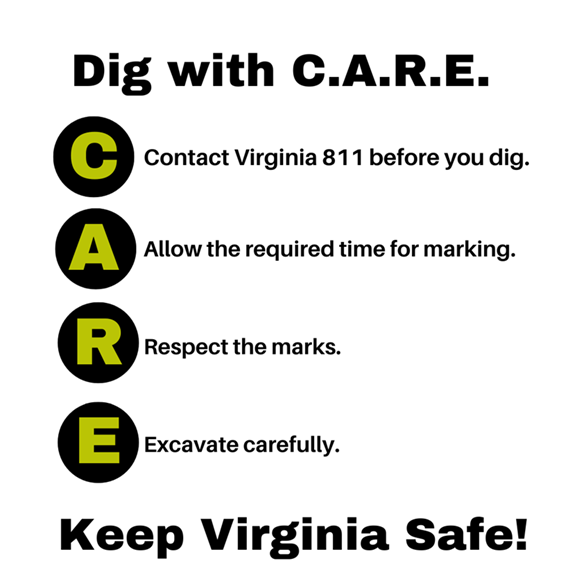
OR Tap the Menu button ![]() and 'Add to Home Screen' or 'Install App'
and 'Add to Home Screen' or 'Install App'
Note: Try using Chrome instead of the built-in browser if having viewing problems on your Android phone.